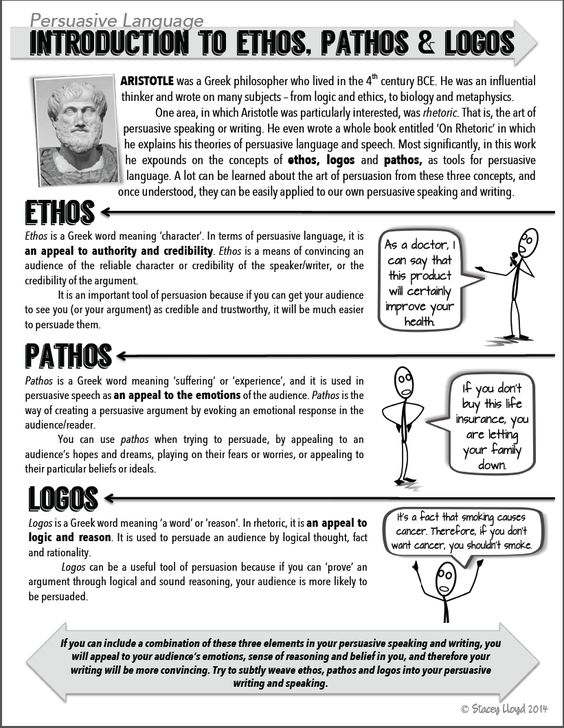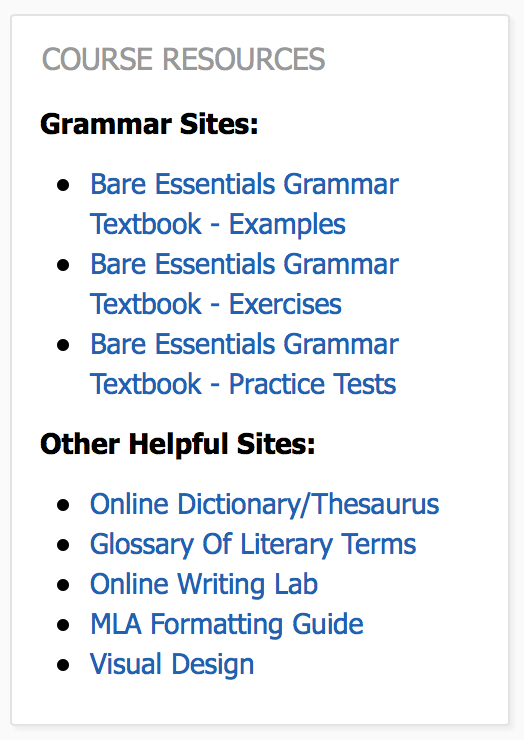Personal and Social Responsibility
| Site: | Cowichan Valley School District - Moodle |
| Course: | ELA10 - Composition (2 credit), CSS, Seipp |
| Book: | Personal and Social Responsibility |
| Printed by: | Guest user |
| Date: | Sunday, 28 December 2025, 2:14 PM |
Introduction
Personal Awareness and Responsibility involves:
- Self-determination
- Self-regulation
- Well-being
Social Responsibility involves:
- Contributing to community and caring for the environment
- Solving problems in peaceful ways
- Valuing diversity
- Building relationships
Consider all of these elements as you work through the assignments in this section.
Summary Explanation of Assignments
Here is a quick overview of the assignments for this unit. However, be sure you read over the specific assignment instructions that follow for each one. Review the marking rubrics for the assignments before you start.
ASSIGNMENT 1: The Art of Persuasion
Learn about and summarize the three methods of persuasion.
ASSIGNMENT 2: On Perspective
Perspective is everything. Write on one topic from different perspectives.
ASSIGNMENT 3: Advertising Responsibly?
Give your opinion in a persuasive paragraph whether advertisers can actually be socially responsible.
ASSIGNMENT 4: How to Write An Editorial
Learn from a New York Times editor how to write an effective editorial by reading and analyzing some examples.
ASSIGNMENT 5: Forum: Editing for Strong Verbs.
Edit a piece to with strong verbs to make a more effective statement. Post yours and then see how others tackled the same task.
ASSIGNMENT 6: PROJECT: What If? Be the Change.
Write a newspaper editorial on a topic that you are passionate about. Identify a problem and how it might be solved.
ASSIGNMENT 1: The Art of Persuasion
|
Learning Target (Curricular Competencies):
|
How do you get exactly what you want just using your words? Over two thousand years ago Aristotle defined three appeals to persuasion to do just that. Watch this video to find out more about the power of persuasion:
Tasks: Summarize and identify the three modes of persuasion in a graphic organizer.
1. After reading the handout below, create a visual graphic organizer to SUMMARIZE the main definitions and how to achieve each type of persuasion. If you need some ideas as to how to create a graphic organizer, here is an example of how to design your visual. You may complete this by hand, scan and submit or use a digital tool or template like bubble.us. Just be sure it is your own work!
Assessment: Below you will find the exemplary criteria used to assess the assignment.
Learning Target: (Exemplary 6/6): Exemplary comprehension of the task and clear accomplishment of the objective. All key elements of the content have been included in a personal, creative summary.
Presentation: Exemplary (6/6): Content is effectively presented in a visual graphic organizer that presents the information in an easily readable and attractive way.
Submission
Use the "4.1 The Art of Persuasion" link on the main page of this section of the course to upload your assignment to your teacher for marking.

ASSIGNMENT 2: On Perspective
|
Learning Target (Curricular Competencies):
|
"There are no facts, only interpretations" ~Fredrick Nietzsche. In order to solve problems, to connect with others, and to understand an issue fully, it is important to be able to consider different perspectives.
Reflect on the importance of considering multiple perspectives and write from multiple perspective on a chosen issue.
Tasks: Open a new word document, title it Assignment 4.2 "On Perspective" and do the following:
1. Read the story "The Blind Men and the Elephant" and in your own words in a well-written paragraph explain what comment is being made on perspective.

2. Using the first person point of view, write two separate fictional paragraphs on a controversial issue or argument. One from the point of view of a parent. One from the point of view of the child. (For example: technology use, curfew times, dating, getting a tattoo etc.) Include emotions, concerns, fears of both parties that might help them understand each other better.
Assessment: Below you will find the exemplary criteria used to assess the assignment.
Learning Target: (Exemplary 6/6): Exemplary comprehension of the task and clear accomplishment of the objective. Both the response and fictional paragraphs show an insightful understanding of the concept of perspective using specific examples.
Written Expression: Exemplary (6/6): Sentence structure and vocabulary are varied, skillfully written, and carefully chosen. Work has been proofread and there are few or no errors in spelling, capitalization, punctuation, and grammar. Content contributes to the central idea and makes insightful connections with logical organization.
Submission:
Use the "4.2 On Perspective" link on the main page of this section of the course to upload your assignment to your teacher for marking.
ASSIGNMENT 3: Advertising Responsibly?
|
Learning Target (Curricular Competencies):
|
Whilst 'cause marketing'/'issue-oriented marketing' has traditionally been the domain of non-profit organizations, many businesses today are associating themselves with a cause or issue. For example, if you shop at the GAP and buy (RED) brand clothing, The Gap will donate money to (RED).
Task: Become aware of the use of persuasive techniques in advertising by considering the following advertisements.
- Who is the target audience of this campaign?
- What is the creative concept of this campaign?
-
What does the Washington Post suggest about society's values and beliefs concerning global warming?
- Do you think these advertisements achieve their objective of raising awareness of global warming, or do they appear disingenuous about this cause?
- What is your overall opinion of company's that align themselves with 'cause/issue advertising.'
Assessment: Below you will find the exemplary criteria used to assess the assignment.
Learning Target: (Exemplary 6/6): Exemplary comprehension of the task and clear accomplishment of the objective. Answers are thoughtful and specific.
Written Expression: Exemplary (6/6): Sentence structure and vocabulary are varied, skillfully written, and carefully chosen. Work has been proofread and there are few or no errors in spelling, capitalization, punctuation, and grammar. Content contributes to the central idea and makes insightful connections with logical organization.
Submission:
Use the "4.3 Advertising Responsibly" link on the main page of this section of the course to upload your assignment to your teacher for marking.
ASSIGNMENT 4: How to Write An Effective Editorial
|
Learning Target (Curricular Competencies):
|
How can writing change people's worldview? How can it influence public opinion? How can it lead to meaningful action? Persuasive writing is more than just an academic exercise — it is very much alive in the real world. Perhaps one of the best and most widely recognized examples of persuasive writing in action is the classic newspaper editorial, three to four of which The New York Times publishes every day.
Task: Identify key elements of a newspaper editorial.
1. Watch this video created for students by The New York Times's editorial page editor Andrew Rosenthal who provides seven tips for writing an effective editorial.
2. Choose an award winning editorial to read from a student contest at the New York Times and answer the questions in the assignment "4.4 How to Write an Effective Tutorial".
Assessment: Below you will find the exemplary criteria used to assess the assignment.
Learning Target: (Exemplary 6/6): Exemplary comprehension of the task and clear accomplishment of the objective. Questions have been thoroughly and accurately answered.
Written Expression: Exemplary (6/6): Sentence structure and vocabulary are varied, skillfully written, and carefully chosen. Work has been proofread and there are few or no errors in spelling, capitalization, punctuation, and grammar. Content contributes to the central idea and makes insightful connections with logical organization.
Submission:
Use the "4.4 How to Write an Effective Tutorial" link on the main page of this section of the course to upload your assignment to your teacher for marking.</p
ASSIGNMENT 5: Editing Forum
|
Learning Target (Curricular Competencies):
|
Task:
Go through the 3 Grammar Resources listed under Course Resources (on the side of the course). These sites are from an online Grammar textbook called The Bare Essentials. There are examples, practice exercises, and practice tests.

Do the practice tests in UNIT 1 (WORDS) and UNIT 4 (PUNCTUATION). If you are not achieving 100% on these tests, review the lesson in the EXAMPLES and the do some practice EXERCISES to review.
In this forum, comment on which of the tests/concepts you found easiest. Which one was most difficult? Was there a concept in these practice tests that was unfamiliar to you? How might you begin to apply these learning lessons into your own writing? Can you see where you might use some of these conventions of language? Provide a discussion of your results and their applications into your speaking and writing. Comment on another's post. Did you get other ideas for applying these grammar lessons into your own writing?
There are TWO activities in a FORUM:
- Go to the main page of the course and click on 4.5 Editing Forum. Start a new discussion topic by clicking on Add a New Discussion Topic.
- Reply/Respond to someone else's discussion topic by clicking on their topic and selecting Reply. Comment on the concepts they chose. Offer advice on learning how to apply these concepts. Try using the following prompts to guide your response to another post. "I wonder…" "I know…" "I can…" Don't just agree or disagree.
Assessment: Below you will find the exemplary criteria used to assess the assignment.
Learning Target: (Exemplary 6/6): Exemplary comprehension of the task and clear accomplishment of the objective. Student has carefully considered prior and new knowledge of word choice including homonyms, apostrophes, capitalization, and numbers in language. Student has carefully considered prior and new knowledge of punctuation rules including commas, semi-colons, colons, quotation marks, and end punctuation. Student demonstrates clear understanding of personal learning.
Response/Reply: Exemplary (6/6): The response/reply is thoughtful, insightful and respectfully exchanges ideas and viewpoints. Student demonstrates an exceptional level of understanding and communication of shared information.
Submission:
Use the "4.5 Editing Forum" link on the main page of this section of the course to post your forum response to your teacher for marking.
ASSIGNMENT 6: PROJECT - What If? Be the Change.
|
Learning Target (Curricular Competencies):
|
How can writing change people’s worldview? How can it influence public opinion? How can it lead to meaningful action? Persuasive writing is more than just an academic exercise — it is very much alive in the real world. Perhaps one of the best and most widely recognized examples of persuasive writing in action is the classic newspaper editorial, three to four of which The New York Times publishes every day.
Task: Using all the steps of the writing process and persuasive techniques, write a newspaper editorial on a topic that you care about.
Step One: Find a topic that you care about.
Finding the right topic is essential. You should pick something that a) you genuinely care about; b) other people would want to read about; c) an argument can be made about it d) and evidence can be found to support your claim.
Consider these questions:
- What would you like to change if you could? What problems or policies do you think should be addressed — whether something global, like climate change, or something closer to home, like a later start time for your high school classes? Make as long a list as you can.
- What issues, topics and fields are you passionate about? Make a list. Your list might include fields as broad as “music” or as specific as “the early days of hip-hop.” What questions or controversies in these fields do experts or fans often argue? Where do you stand?
- What do you do outside of school? What are some things you’re an expert on? What aspects of those hobbies or interests do you find yourself having to explain to others? Why?
- What issues or ideas do you often find yourself discussing or arguing about with friends, your family or online?
- What issues or controversies have you followed recently in current events? What are your opinions about them? What might you need more information about?
Here are some links to topics to consider:
200-prompts-for-argumentative-writing
Student opinion prompts-explore and read further to develop a topic
Step Two: Gather ideas and facts: Using the same strategies in unit 2, complete your research.
Step Three: Create an Outline
Step Four: Write Your Draft
Step Five: Proofread and Edit based on this Checklist
Assessment: Below you will find the exemplary criteria used to assess the assignment.
Learning Target: (Exemplary 6/6): Exemplary comprehension of the task and clear accomplishment of the objective. Final product demonstrates exemplary ability to access information for diverse purposes and from a variety of sources to inform writing and to form a strong opinion with evidence.
Content: (Exemplary 6/6): The content contributes to a clear, central idea and makes insightful connections. Student demonstrates an exemplary ability to provide evidence from suitable sources. The content clearly reflects the student's sense of social responsibility.
Organization: (Exemplary 6/6): The final product demonstrates a thorough understanding of the format of the multi-paragraph composition. There is a clear main idea that is seamlessly developed with engaging and convincing support. The concluding idea makes a strong final statement of the main idea.
Written Expression: Exemplary (6/6): Sentence structure and vocabulary are varied, skillfully written, and carefully chosen. Work has been proofread and there are few or no errors in spelling, capitalization, punctuation, and grammar.
Submission:
Use the "4.6 PROJECT: What If? Be the Change" link on the main page of this section of the course to upload your assignment to your teacher for marking.